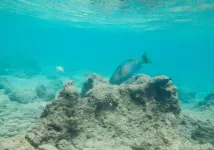Why COVID-19 vaccine distribution methods fall short and 3 ways to improve them
2021-03-01
(Press-News.org) BINGHAMTON, NY - Several proposals have emerged on how to distribute the COVID-19 vaccine, but they fall short in ensuring that the vaccine is distributed fairly. A team including Binghamton University professor Nicole Hassoun suggests three ways to more fairly and effectively distribute the vaccine so that people in poor countries get the vaccine as soon as possible.
"Although many people in rich countries will receive a vaccine for COVID-19 this year, many people in poor countries will likely have to wait years to get one," said Hassoun. "Ethical vaccine allocation requires closing this gap and ensuring that everyone can access a vaccine as soon as possible. We should increase vaccine manufacturing, distribution and uptake. Rich countries should not get to prioritize their populations first."
Several proposals have emerged offering guidelines for how to distribute the COVID-19 vaccine fairly. These include the COVID-19 Vaccines Global Access (COVAX) facility, a collaboration that brings together governments, companies, international organizations, and others to accelerate the development and manufacture of COVID-19 vaccines. Currently, COVAX is set up so that in a first phase poor countries can vaccinate 3% of their populations, while rich countries can vaccinate up to 50%. Another sophisticated proposal, the "Fair Priority" model, suggests countries with vaccines contribute to global distribution once their COVID-19 transmission rates drop below 1.
However, insofar as the aim is to have the greatest health impact, these proposals fall short, according to Hassoun and her team. They offer three suggestions:
1. Proposals for fair distribution must address health problems for individuals. Moreover, since most individuals have little choice as to their country of origin or residence, we should not discriminate against them based on location. A fair proposal cannot allow rich countries to hoard vaccines or prioritize their own populations first. Nor can it give individuals' less priority simply because they live in a country with less infrastructure, capacity, or willingness to distribute vaccines.
2. Allocation principles must explicitly focus on both direct and indirect health effects of COVID-19. Direct health effects include death and disability caused (in full or in part) by the virus. Indirect health effects include death and disability caused (in full or in part) by the social response to the virus.
3. Having greatest global health impact requires assisting countries in their vaccine distribution, production, and consumption. A fair allocation system must consider how vaccine distribution will determine the success of whatever strategy is adopted.
"Many proposals for equitable allocation let rich countries prioritize their populations," said Hassoun. "We must combat this scarcity mindset and expand access rather than just shift resources around."
Additional researchers contributing to this paper include Anders Herlitz, Zohar Lederman, Jennifer Miller, Caesar Atuire, Lisa Eckenwiler, Sridhar Venkatapuram, and Marc Fleurbaey.
The paper, "Just Allocation of COVID-19 Vaccines," was published in BMJ Global Health.
INFORMATION:
ELSE PRESS RELEASES FROM THIS DATE:
2021-03-01
PHILADELPHIA-- Hospital emergency departments (EDs) not only care for patients with overdose and other complications from opioid use, but they also serve as vital touch points to engage patients into longer-term treatment. After an overdose, patients are at risk for repeat overdose and death. Pennsylvania is unique in establishing a voluntary incentive program to improve the rate at which patients with opioid use disorder receive follow-up treatment after emergency department care. Evaluations of the program show that financial incentives are effective in producing rapid treatment innovations for opioid use disorder.
In a study, researchers at the Perelman School of Medicine at ...
2021-03-01
Oak Brook, IL - The March edition of SLAS Discovery features the cover article, "Therapeutic and Vaccine Options for COVID-19: Status After 6 Months of the Disease Outbreak" by Christian Ogaugwu (Federal University Oye-Ekiti, Ekiti State, Nigeria ), Dawid Maciorowski, Subba Rao Durvasula, Ph.D., Ravi Durvasula, M.D., and Adinarayana Kunamneni, Ph.D. (Loyola University Medical Center, Maywood, IL, USA).
This cover article focuses on the therapeutic and vaccine options available against the novel coronavirus, roughly six months after the outbreak; because the COVID-19-related death toll worldwide had reached 500,000 in six months (and ballooned to over 2,000,000 at the time of publishing) the importance of options to temper the disease cannot be overemphasized. The article ...
2021-03-01
Major changes in bereavement care have occurred during the COVID-19 pandemic, amid a flood of demand for help from bereaved people, according to new research from the University of Cambridge. The first major study of pandemic-related changes in bereavement care has found that the switch to remote working has helped some services to reach out, but many practitioners feel they do not have capacity to meet people's needs.
It is estimated that for every death, nine people are affected by bereavement. The scale of the impact of the COVID-19 pandemic on those ...
2021-02-28
MINNEAPOLIS - Obstructive sleep apnea is when breathing is repeatedly interrupted during sleep. Research has shown people with this sleep disorder have an increased risk of developing cognitive impairment and Alzheimer's disease. Yet, it is treatable. A preliminary study released today, February 28, 2021, has found that obstructive sleep apnea is common in people with cognitive impairment. The study will be presented at the American Academy of Neurology's 73rd Annual Meeting being held virtually April 17 to 22, 2021.
Cognitive impairment includes memory and thinking problems that affect ...
2021-02-28
Red supergiants are a class of star that end their lives in supernova explosions. Their lifecycles are not fully understood, partly due to difficulties in measuring their temperatures. For the first time, astronomers develop an accurate method to determine the surface temperatures of red supergiants.
Stars come in a wide range of sizes, masses and compositions. Our sun is considered a relatively small specimen, especially when compared to something like Betelgeuse which is known as a red supergiant. Red supergiants are stars over nine times the mass of our sun, and all this mass means that when they die they do so with extreme ferocity in an enormous explosion known as a supernova, in particular what is known as a Type-II supernova.
Type II supernovae seed the cosmos with elements ...
2021-02-27
Tokyo, Japan - Researchers from Tokyo Metropolitan University have revealed how liquid foams collapse by observing individual collapse "events" with high-speed video microscopy. They found that cracks in films led to a receding liquid front which sweeps up the original film border, inverts its shape, and releases a droplet which hits and breaks other films. Their observations and physical model provide key insights into how to make foams more or less resistant to collapse.
Understanding how foams collapse is serious business. Whether it's ensuring fire extinguishing foams stay long enough to put out flames, cleaning up toxic foams in seas and rivers, or simply getting the perfect rise on a cake, getting to grips with how foam materials collapse is vital to tailoring their properties, ...
2021-02-27
Korea Brain Research Institute (KBRI, President Suh Pann-ghill) announced that the research team led by Dr. Jae-Yeol Joo discovered new cryptic splice variants and SNVs in PLCg1 gene of AD-specific models for the first time using Splice-AI.
This research outcome was published in PNAS, a world-renowned academic journal.
* (Title) Prediction of Alzheimer's Disease-Specific phospholipase c gamma-1 SNV by Deep Learning-Based Approach for High-Throughput Screening
Alternative splicing variant regulates gene expression and influences diverse phenotypes. Especially, genetic ...
2021-02-26
Marine protected areas (MPAs) around O?ahu do not adequately protect populations of herbivorous reef fishes that eat algae on coral reefs. That is the primary conclusion of a study published in Coral Reefs by researchers from the University of Hawai?i at Mānoa School of Ocean and Earth Science and Technology (SOEST).
There are over 20 species of herbivorous fishes and ten species of herbivorous urchins commonly observed on Hawaiian reefs. These species eat algae that grows on reefs, a process called herbivory, that contributes to the resilience of coral reefs by preventing algae dominance that can lead to overgrowth of corals.
The team of researchers found that of the four marine protected areas around O?ahu they assessed in the study, ...
2021-02-26
The ability to read is foundational to education, but prolonged school closures and distance learning due to the pandemic have imposed unique challenges on the teaching of many fundamental skills. When in-person classes resume, many students will likely need a period of catch-up learning, especially those who lag behind in basic reading skills.
New research published in the journal Psychological Science shows that people who were taught to read by receiving explicit instructions on the relationship between sounds and spelling experienced a dramatic improvement compared to learners who discovered this relationship naturally through the reading process. These results contribute to an ongoing debate about how best to teach children to ...
2021-02-26
New research from Baylor College of Medicine scientists shows that a combination of deep brain stimulation (DBS) and exercise has potential benefits for treating ataxia, a rare genetic neurodegenerative disease characterized by progressive irreversible problems with movement.
Working with a mouse model of the human condition, researchers at Baylor and the Jan and Dan Duncan Neurological Research Institute at Texas Children's Hospital discovered that combining DBS targeted to the cerebellum, a major motor center in the brain, and exercise rescued limb coordination and stepping and that the benefits persisted without further stimulation. In addition, the study reports that stimulating mice with early-stage ataxia showed the most dramatic improvements. These and other ...
LAST 30 PRESS RELEASES:
[Press-News.org] Why COVID-19 vaccine distribution methods fall short and 3 ways to improve them



